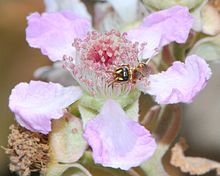bio.wikisort.org - Plant
Rubus ulmifolius subsp. sanctus, commonly called holy bramble,[4] is a bramble native to parts of Asia and Europe.[2]
| Rubus ulmifolius subsp. sanctus | |
|---|---|
 | |
| Flower with a bee (Hylaeus rubicola) | |
| Scientific classification | |
| Kingdom: | Plantae |
| Clade: | Tracheophytes |
| Clade: | Angiosperms |
| Clade: | Eudicots |
| Clade: | Rosids |
| Order: | Rosales |
| Family: | Rosaceae |
| Genus: | Rubus |
| Species: | |
| Subspecies: | R. u. subsp. sanctus |
| Trinomial name | |
| Rubus ulmifolius subsp. sanctus | |
| Synonyms[2][3] | |
This plant is very long-lived. An instance of it can be found at the Chapel of the Burning Bush on Mount Sinai, where it is revered as the original burning bush of the Bible. This longevity and location lead to its Latin name.[5][6]

Chemistry
3,6-Di-O-caffeoylglucose, 1-O-caffeoylxylose and 2,3-O-hexahydroxydiphenoyl-4,6-O-sanguisorboyl-(α/β)-glucose (an ellagitannin constituted with sanguisorbic acid), are found in R. ulmifolius subsp. sanctus.[7]
References
- "Tropicos.org".
- "Rubus sanctus". Germplasm Resources Information Network (GRIN). Agricultural Research Service (ARS), United States Department of Agriculture (USDA). Retrieved 16 January 2018.
- "The Plant List: A Working List of All Plant Species".
- "Rubus sanguineus". Wildflowers of Israel.
- "Places of Peace and Power". Retrieved 15 October 2014.
- "Chapel of the Burning Bush". Retrieved 15 October 2014.
- Caffeoyl sugar esters and an ellagitannin from Rubus sanctus. Sahar A.M Hussein, Nahla A Ayoub, Mahmoud A.M Nawwar, Phytochemistry, Volume 63, Issue 8, August 2003, Pages 905–911, doi:10.1016/S0031-9422(03)00331-5
External links
- "Rubus sanguineus". Plants for a Future.
Wikimedia Commons has media related to Rubus sanguineus.
Wikispecies has information related to Rubus ulmifolius subsp. sanctus.
Текст в блоке "Читать" взят с сайта "Википедия" и доступен по лицензии Creative Commons Attribution-ShareAlike; в отдельных случаях могут действовать дополнительные условия.
Другой контент может иметь иную лицензию. Перед использованием материалов сайта WikiSort.org внимательно изучите правила лицензирования конкретных элементов наполнения сайта.
Другой контент может иметь иную лицензию. Перед использованием материалов сайта WikiSort.org внимательно изучите правила лицензирования конкретных элементов наполнения сайта.
2019-2025
WikiSort.org - проект по пересортировке и дополнению контента Википедии
WikiSort.org - проект по пересортировке и дополнению контента Википедии